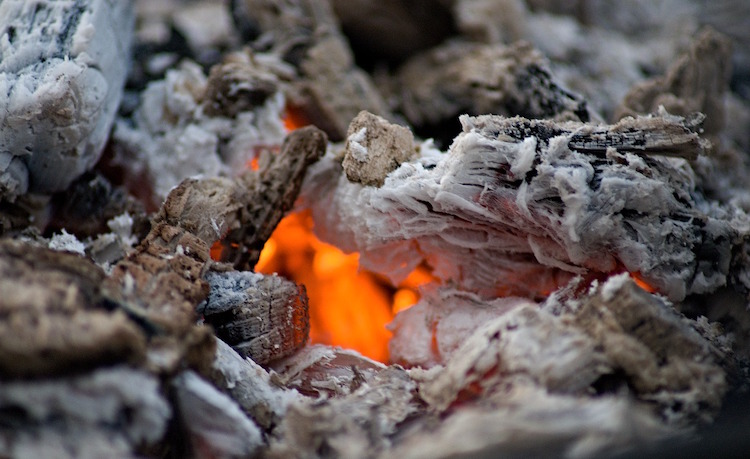Taking an environmentally sensitive approach to pest management
Recycling Wood Ashes
Published: February 2, 2018

Cold winter nights make the warmth of a crackling fireplace or a cozy wood stove particularly pleasant. However, after the fire subsides the task of disposing of the ashes may be a problem. For gardeners, wood ashes spread on garden soils are an excellent and free source of calcium and other essential plant nutrients, if not overdone. An understanding of the action of wood ashes on soil will help to determine when to stop.
Ashes represent the organic and inorganic remains after the combustion of wood. For centuries they have been used for various purposes. Most gardeners are familiar with the term potash when used to describe nutrient forms of the element potassium. The term comes from an early production procedure where potassium was leached from wood ashes and concentrated by evaporating the leachate in large iron kettles or pots. As early settlers cleared land for agriculture and burned the wood, potash sales because an important source of income.
Wood ashes contain other minerals in addition to potassium. Their composition varies due mainly to the species of wood burned. As a rule, hardwood species produce three times more ashes and five times more nutrients than softwood species. Additionally, wood ashes contain few if any elements that represent environmental hazards.
Since carbon, nitrogen and sulfur are the elements primarily oxidized in the combustion process, wood ashes contain most of the other essential elements required for the growth of the tree used as fuel. As an average, wood ashes contain (by weight) 1.5 to 2 percent phosphorous and 5 to 7 percent potassium. If listed as a fertilizer, most wood ashes would have the analysis of 0-1-3 (N-P-K). Not implied in the preceding is the fact that the calcium content of wood ashes ranges from 25 to 50 percent.
The calcium in wood ashes is in the oxide form. When wood ashes are placed outdoors and weathered, the calcium oxide changes to calcium hydroxide, and finally to calcium carbonate. Therefore, because of their high calcium content, it's probably best to think of wood ashes as a liming material to adjust soil pH rather than a regular fertilizer to supply a wide array of nutrients.
The ideal pH range for most garden plants is about 6.0 to 6.5. When soil pH readings fall below this range, certain essential mineral elements become less available to the plant. Since garden soils tend to become more acid as plants take up nutrients, periodic pH adjustment to decrease soil acidity (increase pH readings) is necessary.
Most wood ashes have an acid neutralizing equivalent of about 45 to 50 percent of calcium carbonate (limestone). In other words, it takes about twice the weight of wood ashes compared with limestone to cause the same change in soil acidity. For example, if soil test results indicate your soil needs five pounds of limestone per 100 square feet of garden area to raise the soil pH to an acceptable level, it would require 10 pounds of wood ashes to make the same change.
If small amounts of wood ashes are applied to the garden on a yearly basis to supply other nutrients such as phosphorus and potassium, a soil test every two to three years is recommended. Excessive application of wood ashes can lead to a buildup of pH above the optimum range. This can result in other nutritional problems because of reduced nutrient availability at high pH values.
What constitutes a reasonable application of wood ashes? Five to ten pounds per 100 square feet of garden soil is considered average. If applied as a pre-plant it is best to thoroughly incorporate this amount into the soil three to four weeks in advance of planting. Alternatively, wood ashes can be used as a sidedressing around growing plants. Keep in mind, however, that they are not a rich source of any of the major essential mineral elements other than calcium.
Excess wood ashes not applied to the garden immediately should be stored under dry conditions. Ashes piled outdoors lose most of their potassium content in a year's time due to leaching from rains. Additionally, weathered wood ashes' ability to act as a liming agent also is greatly reduced.
Even though they do contain some carbon, because of the fine nature of wood ashes, they have little effect on soil structure. Therefore, they are not considered to be a soil conditioning agent. The carbon compounds that act as a soil conditioner when sawdust, leaf mold or compost are applied to garden soil, for the most part, have been consumed by the fire that created the ashes.
Wood ashes are highly alkaline. As a safety precaution, wear protective glasses, gloves and a dust mask when spreading them on the garden. Additionally, ashes that result from burning cardboard, trash, coal or treated wood of any type should not be used on the garden, since they make contain potentially harmful materials.
Subscribe to receive similar articles sent directly to your inbox!
- Recycling Wood Ashes (02/02/18)
- Recycling Autumn Leaves (11/09/15)
REVISED: February 21, 2017